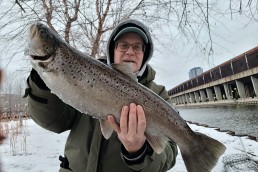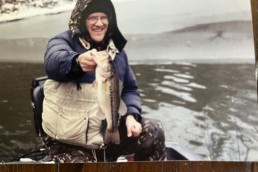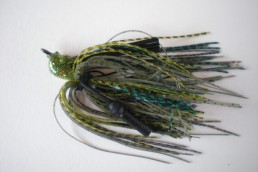Early Arrival for the Kings
SHARE THIS POST
It was pretty dark and the Milky Way was lit up like a Christmas tree as Trevor untied the dock lines and I inched the bow out into the river channel. Several smaller boats had been cruising past from upriver and I could see a string of stern lights ahead—not unusual for a June Algoma morning. As I sipped my coffee, Trevor joined me on the bridge for a brief strategy session. We’d had a generous amount of baitfish hanging in the nearshore areas and yesterday we had faired pretty well just outside of the other boats and on the outer edge of the bait. Today looked similar as we angled to the south out of the harbor. I’ve always preferred a track less traveled.
Finding our open track, I slowed to trolling speed and joined Trevor to set lines. He had a couple in by the time I got there. I kept setting my side, but Trevor had it going. The morning was just getting started, but already the excitement was in high gear. I moved a few rods out of the way and grabbed a net and handed it to Trevor, just in time for him to slide it under the first king salmon of the morning, a stunning 18-pound, well-fed silver king.
But we weren’t done yet.
Trevor was waiting for the second one to make its way to the transom. Then, my corner downrigger set at 45 feet popped and the 7-foot Ugly Stick GX2 bent right toward the water and the reel started screaming out line.
“Here’s one—who’s next?! I shouted.
Are you enjoying this post?
You can be among the first to get the latest info on where to go, what to use and how to use it!
The season for 2017 has been great from the start. With the mild winter and several good rains in place of snow, the fishing has gotten the jump. Browns have been targeted since late February, and the Algoma area has seen one of the most productive starts to the trolling season in years. Lake Michigan warmed up weeks earlier than normal, and with swollen tributaries holding more steelhead for a longer-than-normal stream season, one only wonders when the kings were going to show up. And show up they did. Following a pretty good smelt run, the steelhead exited the rivers and went on a feeding spree. Following the smelt and alewives in nearshore waters came the king salmon. This species was intent on putting the feed bag on with the silver delights along the shallow rocky shoreline.
Algoma has long been known as the “Trout and Salmon Capital of the Midwest,” and for good reason. The shoreline in our area seems to hold baitfish with a unique transition from sandy, stone bottoms to rocky structure. We are in the middle of three large planting sites for kings, and Algoma happens to be home to one of Wisconsin’s largest charter fleets. And these captains really know how to fish. The strong prevailing winds and currents keep baitfish close to the bottom structure here. We also have significant planting sites to make this a top-producing hot spot.
Kings are an eating machine. And given enough food supply to dine on, they can grow to true trophy proportions. The area between Sturgeon Bay and Algoma has a 15-mile stretch that has produced the past two state-record kings salmon, both topping the 40-pound mark, which has the one currently standing at 44 pounds, 15 ounces. The Algoma area has held many big-fish records over the years: the 30-plus-pound brown, pink salmon, hybrid pinook salmon and steelhead. And to make this many big fish in one area, there has to be a good food supply. To keep the food supply of alewives in good numbers, structure helps, but also the small organisms that they feed on need to be present.
The past couple of seasons in the region have seen rivers swell and Lake Michigan rise to levels above normal. This has been a welcome sight to communities to decrease the need to dredge harbors and marinas and has created outstanding fishing opportunities for shore and stream anglers of salmon and trout in the tributaries. Another great sign for a strong fishery is some of the best steelhead this spring, which has translated into very good trolling opportunities later on. The swollen rivers also carry nutrients back out to the lake and have produced nearshore algae blooms that have created a food source for the very bottom of the food chain and that feeds and holds the alewives, the forage for the kings. Combine that with the continued natural reproduction of the king salmon and it kind of creates a perfect storm for a fisherman.
We saw the first king of the year caught in mid-April, weighing in a little over 21 pounds. Given the opportunity to feed all summer, that trophy fish could easily approach 30 pounds by fall. We’re always waiting for that next big fish to break the old record.
MWO
SHARE THIS POST
Did you enjoy this post?
You can be among the first to get the latest info on where to go, what to use and how to use it!
Lee Haasch
Capt. Lee Haasch is a charter captain out of Algoma, Wis., with more than 45 years of Great Lakes angling and guiding experience. Haasch has been instructing anglers for over 30 years with education seminars and timely freelance articles.



